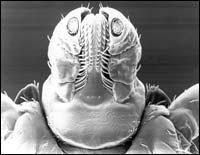Ehrlichiosis
Ehrlichiosis describes several tick-borne bacterial infections originally known to only affect dogs and livestock in the United States, although human disease has been reported in the Far East since the 1950s. Since the mid-1980s, however, bacteria of the genus Ehrlichia have increasingly infected humans in the United States. In June 1999, the Centers for Disease Control and Prevention began listing ehrlichiosis as a reportable disease; 302 cases were reported in 1999.1
| Ehrlichia bacteria live inside the cells of infected individuals and cause two major diseases in the U.S. human population. Human granulocytic ehrlichiosis (HGE) occurs when the bacteria infect granulocytes, specific cells involved in immune responses and allergies. Human monocytic ehrlichiosis (HME) occurs when a different Ehrlichia species infects macrophages, another type of immune cell.
HGE and HME differ, but their symptoms overlap. Both often cause fever, headaches, and aches and pains, but a rash is not as common as with Rocky Mountain spotted fever or Lyme disease. HGE and HME can be treated with antibiotics if the infection is detected early. No vaccine is available. |
 |
NIAID Research
Yasuko Rikihisa, Ph.D., at the Ohio State University, has uncovered several secrets of these recently discovered human pathogens. Her laboratory has begun to reveal how Ehrlichia species attach to, invade, and kill their specific host cells, and how these bacteria attempt to evade the immune systems of infected individuals. Dr. Rikihisa and colleagues have determined genes that encode surface proteins from different Ehrlichia species and are evaluating their promise as future vaccine targets. In addition, her laboratory is determining the genetic blueprint of the different Ehrlichia species in order to learn how each is adapted to its unique lifestyle. By understanding the underlying genetics of these bacteria she hopes to reveal key drug or vaccine targets.
David Walker, M.D., of the University of Texas Medical Branch at Galveston, has long studied and identified new pathogens, specializing in Ehrlichia species and the related bacterium Rickettsia rickettsii, which causes Rocky Mountain spotted fever. He currently studies how the body generates protective immunity against the Ehrlichia species that causes HME. His studies of Rickettsia are described here.
Johnathan Ravdin, M.D., of the University of Minnesota, Twin Cities, seeks to learn more about HGE. Dr. Ravdin studies how Ehrlichia survives within both humans and ticks, and investigates how the body's immune system responds to Ehrlichia invasion.
Fred Kantor, M.D., from Yale University studies the human immune response to tick saliva as he seeks to find an approach to preventing tick-borne diseases like ehrlichiosis and Lyme disease. His laboratory has identified several proteins in tick saliva that lead to tick immunity in guinea pigs, and continues to study these proteins with an eye towards using them in vaccines or treatments for tick-borne diseases.
Harvard University's Sam Telford, Ph.D., studies the population biology of tick-borne organisms like Ehrlichia, Babesia, and the Lyme disease bacterium Borrelia. He seeks to understand how diverse microbes can perpetuate by cycling between deer ticks and small rodents. The potential for concurrent infection ("coinfection") may help explain the disease burden in New England and the spectrum of illnesses associated with exposure to deer ticks.
Additional links:
CDC backgrounder on ehrlichiosis
1. Centers for Disease Control and Prevention. Summary of Notifiable Diseases, United States, 1999. Morbidity and Mortality Weekly Report 2001;48:1-104.